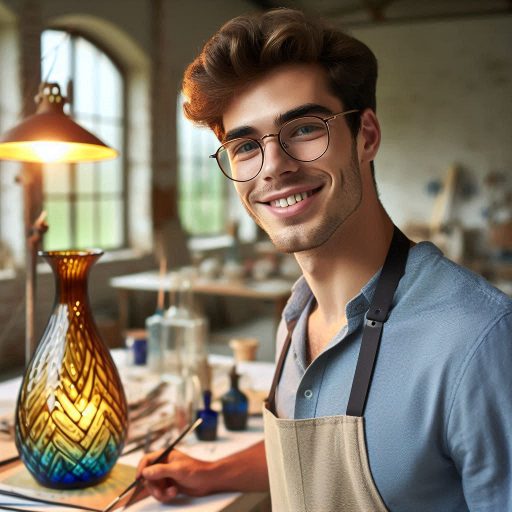Introduction
Glass art is a captivating and intricate craft.
To create stunning pieces, glass artists need the right tools.
Each tool plays a vital role in shaping and manipulating glass.
Having the right tools ensures precision and enhances creativity.
The primary tool every glass artist needs is a glass cutter.
This essential tool allows artists to score glass sheets accurately.
Next, torches and kilns are crucial for heating glass to its melting point.
Artists use these tools to create shapes and effects that bring their visions to life.
Pliers and tweezers help artists handle hot glass safely.
These tools provide the grip needed to work with intricate designs.
Additionally, grinding wheels smooth edges and refine shapes.
This step is essential for achieving professional-looking results.
Safety equipment is equally important.
Safety glasses and gloves protect artists from sharp glass shards and heat.
Investing in quality tools not only improves safety but also boosts artistic potential.
In summary, having the right tools is vital for glass artists.
They enhance creativity, ensure safety, and enable precision.
With the correct equipment, artists can transform their ideas into beautiful glass art.
A well-equipped studio empowers artists to explore their craft fully.
Cutting tools
Different types of cutting tools such as glass cutters and tile nipper
- Glass cutters: These tools are essential for scoring and cutting glass sheets accurately.
- Tile nipper: Useful for making small cuts and shaping glass pieces effectively.
Importance of precision cutting in glass art
- Precision cutting ensures clean edges and precise shapes in glass artwork.
- Accurate cuts are necessary for fitting glass pieces together seamlessly in a design.
- Proper cutting tools help artists achieve their desired designs with ease and accuracy.
- Quality cutting tools contribute to the overall craftsmanship and professionalism of glass artwork.
Read: Famous Glass Artists and Their Works
Transform Your Career Today
Unlock a personalized career strategy that drives real results. Get tailored advice and a roadmap designed just for you.
Start NowSafety equipment
When it comes to working with glass as an artist, safety should always be your top priority.
Here are some essential tools and equipment that every glass artist should have:
Importance of safety goggles and gloves in glass art
One of the most important tools for a glass artist is safety goggles.
These goggles protect your eyes from glass shards and debris that can be created during the glassworking process.
It is crucial to invest in a good pair of safety goggles that fit securely and comfortably on your face.
Another essential piece of safety equipment for glass artists is gloves.
Gloves protect your hands from cuts, burns, and other injuries that can occur when working with glass.
Make sure to choose gloves that are specifically designed for working with glass materials, as they provide better grip and protection.
Proper Safety Measures
- Always wear safety goggles and gloves when working with glass to prevent injuries.
- Avoid wearing loose clothing or jewelry that can get caught in the glassworking equipment.
- Ensure proper ventilation in your workspace to prevent exposure to harmful fumes or gases released during the glassworking process.
- Use tools such as glass cutters and grinders with caution and follow the manufacturer’s instructions carefully.
- Keep your workspace clean and organized to avoid accidents and injuries caused by tripping over clutter or misplaced tools.
By following these safety measures and investing in quality safety equipment, you can protect yourself while creating beautiful glass art pieces.
Remember, safety first!
Read: How to Start a Career as a Glass Artist
Kiln or torch
When it comes to glass art, one essential tool that every artist needs to have is a kiln or torch.
These tools play a crucial role in the glass-making process, helping artists create beautiful and unique pieces.
Let’s dive into the importance of kilns and torches in glass art, as well as explore the different types available for artists to use.
Role of a Kiln or Torch in Glass Art
A kiln or torch is essential for glass artists because it allows them to heat and manipulate glass in a controlled environment.
This is crucial for ensuring that the glass reaches the correct temperature for shaping and forming without cracking or breaking.
Additionally, kilns and torches help artists anneal their glass pieces, which is a process that involves cooling the glass at a controlled rate to relieve internal stresses and strengthen the finished piece.
Without proper annealing, glass pieces are more likely to break or shatter.
Types of Kilns Available for Glass Artists
There are several types of kilns that glass artists can choose from, depending on their specific needs and preferences.
Some of the most common types include:
Transform Your Career Today
Unlock a personalized career strategy that drives real results. Get tailored advice and a roadmap designed just for you.
Start Now- Electric Kilns: Electric kilns are a popular choice for glass artists because they are easy to use and offer precise temperature control.
They are ideal for small to medium-sized pieces. - Gas Kilns: Gas kilns are another option for glass artists, offering the ability to reach higher temperatures than electric kilns.
They are often used for larger pieces or special techniques that require extreme heat. - Raku Kilns: Raku kilns are designed for a specific firing technique called raku, which involves removing pieces from the kiln while they are still red hot and placing them in combustible materials to create unique surface effects.
Types of Torches Available for Glass Artists
For artists who work primarily with flame-working or glass blowing, torches are essential tools that allow for precise control over the heat and shape of the glass.
Some of the most common types of torches used by glass artists include:
- Surface-Mix Torch: Surface-mix torches combine fuel and oxygen at the tip of the torch, creating a softer, more stable flame that is ideal for delicate work like detailed glass bead making.
- Propane Torch: Propane torches are commonly used for glass blowing and shaping larger pieces.
They provide a hotter, more concentrated flame that is suitable for larger-scale projects. - Oxygen-Propane Torch: Oxygen-propane torches offer a versatile option for glass artists, allowing them to adjust the flame temperature and intensity based on their specific needs.
They are often used for a wide range of glass art techniques.
In essence, kilns and torches are essential tools for glass artists that help them create stunning pieces of art through controlled heating and shaping processes.
By understanding the role of these tools and selecting the right type for their needs, artists can unleash their creativity and produce unique works of glass art.
Read: Art and Design Collaborations: Benefits and Challenges

Glass grinder
When it comes to creating stunning glass art pieces, having the right tools is essential.
One of the most important tools in a glass artist’s arsenal is a glass grinder.
Importance of a Glass Grinder
A glass grinder is crucial for smoothing and shaping glass pieces to perfection.
It allows artists to refine the edges of their work, ensuring a clean and professional finish.
Here are some key reasons why a glass grinder is a must-have tool for glass artists:
- Precision: A glass grinder enables artists to achieve precise shapes and angles, giving them full control over their designs.
- Efficiency: Grinding glass by hand can be time-consuming and inconsistent.
A glass grinder speeds up the process and ensures uniform results. - Safety: Working with sharp glass edges can be hazardous.
A glass grinder helps artists smooth out rough edges, reducing the risk of cuts and injuries.
Enhancing the Overall Quality
Using a glass grinder can significantly enhance the overall quality of glass art projects.
Here’s how:
- Professional Finish: A glass grinder can help artists achieve a professional finish on their glass pieces, making them look polished and refined.
- Versatility: With a glass grinder, artists can easily switch between different grinding bits to create a variety of effects and textures in their work.
- Customization: Glass grinders allow artists to customize their glass pieces by shaping them according to their unique vision and style.
Overall, a glass grinder is an indispensable tool for any glass artist looking to take their creations to the next level.
It offers precision, efficiency, safety, and the ability to enhance the overall quality of glass art projects.
Read: Essential Tools for Mural Painting and Design
Glass fusing supplies
When it comes to creating stunning glass art pieces, glass fusing supplies play a crucial role in adding intricate details and textures to your work.
Here are some essential glass fusing supplies that every glass artist should have:
Glass Frits
Glass frits are small granules of colored glass that can be used to add vibrant pops of color to your glass art pieces.
They come in a variety of sizes, from fine powder to larger chunks, allowing you to create different effects and textures in your work.
By sprinkling glass frits onto your glass base and then firing it in a kiln, you can create beautiful patterns and designs that can’t be achieved with solid colored glass alone.
Transform Your Career Today
Unlock a personalized career strategy that drives real results. Get tailored advice and a roadmap designed just for you.
Start NowStringers
Stringers are thin rods of colored glass that can be used to create fine lines, intricate details, and delicate patterns in your glass art pieces.
They are perfect for adding definition and depth to your designs, whether you’re creating a floral motif, geometric shapes, or abstract patterns.
Stringers can be bent, twisted, and layered to create unique effects, making them a versatile tool for glass artists looking to add dimension to their work.
Molds
Molds are essential for shaping and forming glass into specific shapes and sizes, especially when creating functional pieces like bowls, plates, or ornaments.
They come in a variety of shapes and sizes, allowing you to experiment with different forms and structures in your glass art.
Some molds are made from ceramic or stainless steel, while others are reusable silicone molds that can withstand multiple firings in a kiln.
Overall, glass fusing supplies are essential tools for glass artists looking to elevate their work and create visually stunning pieces that showcase their creativity and skill.
Whether you’re a beginner or an experienced artist, having a variety of glass frits, stringers, and molds in your studio will open up a world of possibilities for your glass art projects.
Explore Further: Art Therapy for Veterans: Healing Through Creativity
Pliers and tweezers
When it comes to working with delicate glass pieces, having the right tools like pliers and tweezers is essential for glass artists.
Importance of pliers and tweezers
- Help in handling fragile glass pieces with precision
- Avoid damaging the glass while working on intricate designs
- Provide better control and grip over the glass
- Assist in bending, shaping, and holding glass pieces in place
- Ensure safety by reducing the risk of accidental cuts or injuries
Types of pliers commonly used by glass artists
- Flat-nose pliers: Ideal for gripping and bending flat surfaces of glass
- Round-nose pliers: Perfect for creating loops, curves, and coils in glasswork
- Wire-cutting pliers: Essential for cutting wires and thin glass rods
- Needle-nose pliers: Useful for reaching tight spaces and holding small glass pieces
- Bent-nose pliers: Great for getting into tricky angles and making precise bends
Types of tweezers commonly used by glass artists
- Curved tweezers: Enable artists to pick up small objects with ease
- Flat-tip tweezers: Perfect for handling delicate glass pieces without scratching them
- Sharp-point tweezers: Great for precision work and intricate details on glass
Having a variety of pliers and tweezers in your toolkit will not only make your glass art projects more manageable but also ensure that you can work on intricate designs with precision and finesse.
UV lamp or UV resin
When it comes to creating stunning glass art projects, having the right tools is essential.
One important tool that every glass artist should have in their arsenal is a UV lamp or UV resin.
These tools can make a significant impact on the quality and durability of your glass art pieces.
How UV Lamps or UV Resin Can Be Used to Cure Glass Art Projects
UV lamps and UV resin are commonly used in the glass art world to cure or harden certain types of materials.
When working with UV resin, artists can apply the resin to their glass projects and then use a UV lamp to cure it.
The UV light activates the resin, causing it to harden and create a durable finish on the glass.
UV lamps are also used to cure certain types of paint or coatings that are applied to glass surfaces.
By using a UV lamp, artists can speed up the curing process and ensure that their projects are finished quickly and efficiently.
The Benefits of Using UV Technology in Glass Art Creation
There are several benefits to using UV lamps or UV resin in glass art projects.
Transform Your Career Today
Unlock a personalized career strategy that drives real results. Get tailored advice and a roadmap designed just for you.
Start NowOne of the main advantages is the speed of the curing process.
UV technology allows artists to cure their projects quickly, which can be especially beneficial when working on tight deadlines or with time-sensitive materials.
Another benefit of using UV technology is the level of control it provides.
With UV lamps or UV resin, artists can easily control the intensity and duration of the UV light exposure, allowing them to achieve the desired level of hardness and finish on their glass projects.
UV technology also offers a high level of precision in curing glass art projects.
The focused UV light ensures that the resin or coatings cure evenly, with no streaks or uneven spots.
This results in a professional-looking finish that enhances the overall quality of the artwork.
UV lamps and UV resin are indispensable tools for glass artists looking to create high-quality, durable glass art pieces.
By using UV technology, artists can speed up the curing process, improve control over the curing process, and achieve a precise and professional finish on their projects.
Whether you are a seasoned glass artist or just starting out, incorporating UV technology into your toolkit can take your glass art to the next level.
Invest in a quality UV lamp or UV resin today and experience the benefits of this innovative technology in your glass art creations.
Find Out More: Motion Graphics Design: Project Management Tips
Conclusion
Investing in quality tools is crucial for glass artists.
The right tools can improve efficiency, precision, and safety while working on projects.
From basic tools like glass cutters and pliers to advanced tools like kilns and grinders, each tool plays a vital role in the artistic process.
By using the right tools, artists can bring their creative visions to life and create stunning pieces of glass art.
It’s important to research and invest in high-quality tools that will stand the test of time and help artists achieve professional results.
So, whether you’re a beginner or a seasoned glass artist, don’t underestimate the power of having the right tools at your disposal.
Enhance your glass art projects by equipping yourself with the essential tools needed to succeed.
[E-Books for Sale]
The Big Book of 500 High-Paying Jobs in America: Unlock Your Earning Potential
$19.99 • 500 High-Paying Jobs • 330 pages
Explore 500 high-paying jobs in America and learn how to boost your career, earn more, and achieve success!
See All 500 High-Paying Jobs of this E-Book
1001 Professions Without a Degree: High-Paying American Jobs You Can Start Now
$19.99 • 1001 Professions Without a Degree • 174 pages
Discover 1001 high-paying jobs without a degree! Unlock career tips, skills, and success strategies for just $19.99!




